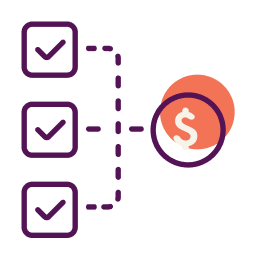- Vertical integration is a business model that businesses can use to gain competitive advantage and increase their market share by gaining control of their supply chain.
- As a business strategy, vertical integration involves one company purchasing or acquiring a supplier or distributor in an expansion deal.
- Read on to find out more about vertical integration and how your business can use it to get a leg up on your competitors.
What is Vertical Integration?
Vertical integration allows companies to gain control over aspects of their supply chain, typically through an acquisition or merger. If a company gains control over every aspect of its supply chain, from raw materials to to distribution, they achieve full vertical integration
Most businesses that sell a product use outsourcing to handle aspects of the product’s lifecycle, including design, creation, and shipping. While this kind of supply chain is usually very efficient for all companies involved, it can sometimes make the process of delivering goods to customers more complicated.
If a business wants to streamline its operations for producing and distributing its products, it can buy one or more of the companies that serve as a link in the supply chain. By bringing the provider under the company’s umbrella, it can reduce disruptions, lower costs, and streamline the production process, making it more competitive against other companies that provide the same product.
Vertical Integration Example
There are many examples of vertical integration in the real world, but we’re going to use a fictional company called Sally’s Scents for this example.
Sally’s Scents is a home goods company that specializes in scents for the home, including candles, room sprays, and diffusers. They design their scents in-house, as well as their own packaging and marketing materials. They also handle orders, shipping, and customer service from their office.
Sally’s Scents uses a separate candle manufacturing company, Candlemania, to produce their candles and source raw materials. They use another factory, Scents n Stuff, to produce their diffusers and room sprays. Both companies provide excellent products, but their turnaround times are slower than Sally’s Scents would like.
A new scent company, Marnie’s Magic, starts producing similar products to Sally’s Scents, and quickly gains traction in the home scent world. Sally’s Scents would like to offer a similar service to its customers but knows it’s not possible to do so in a timely manner because their supply chain is so spread out.
So Sally’s Scents decides to buy both Candlemania and Scents n Stuff and bring them under their umbrella so they can more efficiently produce both their signature line and custom products for customers. The newly integrated company enables Sally’s Scents to be more competitive with Marnie’s Magic, while opening their product line to even more options and thus more customers.
Vertical Integration vs. Horizontal Integration
Many businesses are looking for economies of scale — ways they can save costs while still increasing output — as a way to gain a competitive advantage. Both vertical and horizontal integration can be one way to accomplish this.
While a vertical integration strategy means acquiring providers you already work with in your existing supply chain, horizontal integration means acquiring competitors in your industry. Through horizontal integration, you combine your supply chains, operations, and assets, allowing you to grow in size, expand your product offering, and get your products in front of new customers faster than before.
Types of Vertical Integration
There are three types of vertical integration: backward integration, forward integration, and balanced integration.
Backward Integration
When a company uses backward vertical integration or upstream integration, they acquire a business or provider who provides goods or services earlier in their supply chain. This usually means raw material providers, inventory producers, or other lines at the beginning stages of production. One example of this might be a trucking company acquiring the gas stations that fuel its truck fleets, or the oil refineries that source gasoline to the gas stations.
Forward Integration
Forward vertical integration or downstream integration means acquiring a provider who handles operations closer to the end of a sales lifecycle, such as distributors. This could mean acquiring companies that were once customers, too.
Forward integration can also mean removing a middleman (i.e. a distributor) from the supply chain without necessarily acquiring the company that handles distribution. For example, if Sally’s Scents wants to achieve forward integration, they might sell directly to consumers via their website rather than through a store like Target or WalMart.
Balanced Integration
Balanced vertical integration means using both forward (downstream) and backward (upstream) integration to consolidate the supply chain.
Pros and Cons of Vertical Integration
The benefits of vertical integration include:
- Greater control over supply chain and operations
- Better efficiency and quality control of the final product
- Reduced costs of production and distribution due to lower transaction costs
- Better brand recognition in the market
- Ability to offer lower prices to consumers
- Ability to increase production
- Better profit margins
- Greater market power and other competitive advantages
However, there are also a number of disadvantages that vertical integration may bring to a company, such as:
- The high cost of acquiring other companies
- Loss of flexibility
- Logistics challenges in trying to run all aspects of the company at once
- Confusion over roles and responsibilities
4 Examples of Vertical Integration
Small business vertical integration can be difficult due to the expense of acquiring another company, as well as the cost of merging systems and personnel. Even larger businesses can find it difficult to successfully navigate vertical integration.
As the Harvard Business Review research project notes, “Studies based on the PIMS (profit impact of market strategies) database and other evidence show that high investment intensity usually leads to low profitability. The implication is that unless the operating cost savings of vertical integration are substantial, investment intensity will make integration strategies unprofitable.”
Yet it is still a popular approach to growth and cost savings. Here are recent examples of vertical integration in practice:
Winnebago Industries, Inc., which manufactures popular recreational vehicles, announced in 2023 that it had reached a definitive agreement to acquire Lithionics Battery (“Lithionics”), a lithium-ion battery solutions provider to recreational equipment and specialty vehicle markets. Among the benefits it announced was “strategic sourcing benefits” that help “secure a critical area of its supply chain.”
Voya Financial, Inc., a leading health, wealth and investment company, announced in 2022 it acquired Benefitfocus, Inc., an industry-leading cloud-based benefits administration technology company that serves employers, health plans and brokers. It noted the acquisition would “accelerate Voya’s strategy in health and wealth solutions, adding broad-based benefits administration capabilities that extend its reach across workplace benefits and savings.”
CVS Health in 2023 announced it was closing its acquisition of Signify Health, a network of 10,000 clinicians across 50 states, allowing it to enter into the home health market. This will allow it to increase its reach in underserved and new markets. Among the benefits it announced, noted the acquisition “will strengthen our ability to expand and develop new product offerings in a multi-payor approach.”
British fashion group Burberry Group Plc announced in 2023 it will acquire its Italian supplier Pattern SpA in Turin Italy. Pattern has produced luxury ready-to-wear including quilts and downs. With this acquisition, Burberry says it “will secure capacity, build technical outerwear capability and further embed sustainability into its value chain.”
After discussing the risk of vertical integration, the HBR article notes that “vertical integration is often a highly successful strategy. Especially for businesses and companies that enjoy strong market positions, increased integration can pay off in both profitability and greater product innovation.”
How to Implement Vertical Integration
There are a number of ways to implement vertical integration, although the most common is to buy a company that manages an outsourced aspect of your supply chain or production line. Another way is to cut out the middleman for distribution by selling directly to consumers.
Acquiring another company is an expensive endeavor, and many businesses won’t have the cash flow to simply purchase a company outright. One solution for this problem is to get business financing.
Options for financing vertical integration include:
- Cash or company profits — perhaps the simplest method. However, buying a company with cash-on-hand outright is not always an option for small businesses.
- Small business loans — whether it’s from a traditional bank or the Small Business Administration (SBA), loans can help spot the capital needed to complete an acquisition.
- Equity financing — companies may agree that the acquired company and shareholders get a percentage of the combined profits once a merge is complete.
- Seller notes or seller equity — instead of cash or a full upfront payment, the seller can agree to give the purchased company a seller’s note a few years down the line to complete the purchase. They can also promise equity in the new company. This is an option for acquired companies confident the integration will lead to greater profits down the road. It also allows the acquired company to continue participating in the new company’s operations.
- Private equity or private investors — you may be able to find third parties looking for investment opportunities.
If you’re looking to implement vertical integration and are searching for the right business loan, Nav can help. We use your information to match you to loans and financing options, saving you time and resources. Get started with Nav today.
This article was originally written on April 30, 2022 and updated on March 28, 2023.




Have at it! We'd love to hear from you and encourage a lively discussion among our users. Please help us keep our site clean and protect yourself. Refrain from posting overtly promotional content, and avoid disclosing personal information such as bank account or phone numbers.
Reviews Disclosure: The responses below are not provided or commissioned by the credit card, financing and service companies that appear on this site. Responses have not been reviewed, approved or otherwise endorsed by the credit card, financing and service companies and it is not their responsibility to ensure all posts and/or questions are answered.